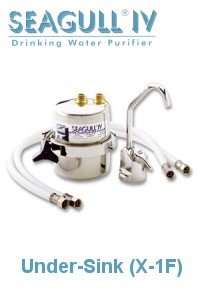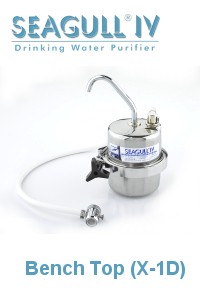WARNING:
If You Are Looking For a Water Purifier,
Don't Do Anything Until You Read This:
Your Family's Health Is Too Important To Jeopardise!
Like me, you try to do what is best for your family and in the modern world that can sometimes be difficult - especially when it comes to what you can give them to eat and drink. We are exposed to more chemicals (intentional and unintentional!) in our food and water than our parents and grandparents ever were. Some of them, for example, chlorine, are actually added to the water to make it "safer". Others end up there as a result of industry, agriculture, accidents, natural disasters, human (or computer) error and waste water treatment.
You may be shocked to discover that there are things in your water that should definitely not be there and that some things you thought were safe, aren't.
But Chlorinated Water Is Safe - Isn't It?
Consider chlorine which is one of the "safe" chemicals. Studies show a link with cancer due, primarily, to the presence of Trihalomethanes (THMs). THMs are produced when chlorine reacts with organic matter such as leaf litter. For example, one study[1] looked at bladder cancer and found that people living in industrialised countries had double the risk of bladder cancer due to THMs in chlorinated water.
The links between chlorine and breast cancer have been well established by multiple studies. The results of a 1992 study in Hartford, Connecticut found that women with breast cancer had 50% to 60% higher levels of chlorinated by-products in their breast tissue than women without the disease.
Other studies have linked chlorinated water to reproductive and developmental effects in children, and heart disease.
And it is not just children. Even the unborn can suffer because of chlorine ingested by the mother. One study found that jaundice was nearly twice as likely to occur in newborns whose mothers drank chlorinated water during pregnancy. The newborn babies were also more likely to have a smaller body length and head size. You don't have to take my word for it. Just do a quick search and you will find references to these studies and a whole lot more. Yet this chemical is considered safe.
Sure, chlorinated water may be better than typhoid (which is why it was originally added to municipal water supplies) but, now that know the damage it can do, we need to take steps to protect ourselves and our families. The thing is, though, chlorine is not the only chemical in your water...
Drugs In My Drinking Water? No Way!
Roughly 100 pharmaceuticals have been identified in rivers, lakes, and coastal waters throughout Europe and the United States. The drugs include cholesterol regulators, analgesics, painkillers, antibiotics, sex hormones, antibiotics, epilspsy drugs and anti-seizure medications as well as potential endocrine disruptors, and caffeine. This is not surprising since anywhere from half to almost all of a drug taken by patients can pass through their bodies without being absorbed or metabolised. Wastewater treatment plants are not designed to remove pharmaceuticals (or other drugs) from sewerage and so this ends up in water you are possibly drinking.
While the concentrations are not high (parts per billion to parts per trillion), no one knows what the effect of long-term exposure is - especially on the developing body of a young child. What is known, however, is that feminisation of male fish occurs with exposure to sewage effluent containing ethinyl estradiol, the active ingredient in birth control pills.
Do you really want to take the chance that these drugs won't affect you or your family? I don't.
With recycled water being used or introduced in many areas, the issue of pharmaceuticals in drinking water is going to become more topical. Yes, we have been told that the treatment plants are producing water that is purer than the water we are already drinking (if so, why not just upgrade our existing water plants?). With any system (not just water treatment) there is always the possibility of human or computer error. Have you ever had your computer crash? Then you know it is true. If the computer controlling a recycled water plant crashes or malfunctions you can't get the water back out of the pipes. Having come from an IT background and having worked with many programmers, I can confidently state that it is not a matter of if the computer malfunctions, but when. If the operator makes a mistake the result is the same - inadequately purified water can end up in the pipes.
Lest you think I am scaremongering - no, I'm not. But it would be irresponsible of me not to make you aware of these issues - especially when there is something you can do to protect yourself against drinking water contamination.
Microbes Living in Your Drinking Water
A glass of water looks clear and pure to the naked eye. Under a microscope the picture is very different. Bacteria (such as E. Coli) and cysts (such as cryptosporidia and giardia) are invariably found in water catchments and in tank or well water. These microorganisms cause gastroenteritis, salmonella infection, dysentery, shigellosis, hepatitis, and giardiasis (a gastrointestinal infection causing diarrhoea, abdominal cramps, and flatulance). At best you will suffer minor symptoms; at worst, the symptoms can be serious and even fatal in the very young, the very old or those with weakened immunity.
It makes little difference whether you are on town water, tank water or well water. Bacteria occur everywhere.
Chlorine is added to municipal drinking water supplies to eliminate these pathogens. Initially it was effective. Today, however, micro-organisms are developing a resistance to chlorine. And, as we have already discussed, it introduces its own set of problems.
I Use Bottled Water - So I'm Okay, Aren't I?
In most cases, the water inside the bottle has been nowhere near the pristine moutnain spring shown on the label - but the label looks good and encourages you to buy the water. Usually, it is filtered tap water. On the rare occasions where it is sourced from a spring, the water is filtered and sometimes disinfected before being bottled.
So, at best you are getting water that may contain some beneficial elements; at worst, you are getting plain old tap water.
Let's ignore the cost and inconvenience of buying bottled water and paying anywhere from $0.50c to $2.00 a litre. Let's also ignore the huge amount of landfill that results from the disposal of plastic bottles and the waste of resources that are used to produce and transport those bottles.
Instead let's look at the issue of BPA (Bisphenol-A).
In recent years there have been lots of comments regarding the safety vs dangers of BPA. This is an industrial chemical used as the starting material for the production of polycarbonate plastics and synthetic resins. It is known as an endocrine disruptor (or environmental estrogen) since it can mimic the effects of sex hormones on the body. The consensus at the moment appears to be that heat causes the BPA to leach from the plastic into the food or water in the container. While there is still some disagreement over the amount of BPA which is harmful, the fact remains that it is a substance it would be better to avoid.
Since bottled water is stored in plastic bottles and you do not know what temperature the bottles have been subjected to during transport or storage, you cannot know how much BPA may be present in the water. So it is best to avoid drinking it unless you are travelling and do not have access to filtered or purified tap water - or a portable water purifier.
By the way, most baby bottles are made from plastic these days and babies are given warm fluids in them. Given the potential for leaching of BPA and given that the baby's body mass is so small, the amount of BPA per kilogram is much higher for a baby than for an adult. So the effects of BPA are much more potent in the baby. You are better off using glass baby bottles if you can get them.
What About Reverse Osmosis Water Filters?
Reverse Osmosis systems can be good depending on what is in your water. Under the right conditions, they can desalinate water but, unless you use seawater, that is probably not of much interest to you. Where, I feel, RO systems fall down is that
- they waste water;
- they do not remove THMs unless combined with pre- or post-filtration;
- they are often s-l-o-w to produce pure water;
- they usually remove all trace elements from your water even the beneficial minerals;
- they are not suitable for use on microbiologically unsafe water unless you first "purify" it, and
- the membrane typically has to be replaced every 6 months or so depending on the particular RO system.
Don't get me wrong, I'm not knocking RO systems; I just don't believe they are the solution to provide pure drinking water. If you already have a Reverse Osmosis system, that's great. It is certainly better than nothing at all.
What about Water from Air machines?
Isn't that the ultimate pure water?
These machines are a great idea in the appropriate environment. That environment is a warm and wet one (at least 26°C and 60% relative humidity) and where a water main or other potable water source is not readily available.
Their main disadvantages are that they are
- big (having a generator and a purifier),
- expensive,
- require significant electricity to operate (between 600 - 1200 Watts),
- have a lot more parts to potentially fail or be replaced (pumps and motors), and
- they are s-l-o-w producing from 20 to 100 litres per day under ideal conditions.
From an economics point of view, these machines are not really a cost-effective option, especially now that electricity prices have risen and are foreshadowed to rise again.
Also, these machines are inside and derive their moisture from the air in the building - which includes exhaled air from the occupants of the building. I know the water is filtered, but somehow I just don't like the idea of drinking someone else's exhalations.
Common Filtration Problems
Many filter systems suffer from at least one of the following problems:
- they are slow at producing pure water;
- they only remove some of the nasties from your water; or
- they are expensive to operate and maintain
This means that you tend not to use the water for cooking, washing fruit and vegetables etc as it takes so long to produce; or, you use the water but the end result is that you are still ingesting the contaminants even if it is at a lower concentration than it would be without the filter.
So, How Do We Get Pure Water?
Since water is subject to a range of contaminants, the solution is to purify it at the Point Of Use (POU). That way, it doesn't matter what happens before or after the water treatment plant, you can be assured of pure water in your home.
If you are giving your family water to drink you want it to be safe. Further, you don't want the hassle of having to wait for it to be produced. You want it when you need it. You also want it to be cheap enough that you can wash your fruit and vegetables in it without feeling guilty that you are wasting money.
The ideal water purification system is one where you get pure water on demand at a reasonable cost per litre.
The criteria for such a water purifier are:
- Effective - It has to get rid of all the bad stuff including pathogens
- Efficient - No wasted water
- Self-contained - No batteries, electrical connection or chemicals required
- Cost-Effective - Replacement part(s) must be reasonably priced and available
- Instant - No waiting time - suspect water in, pure water out immediately
- Reliable - You want something you can rely on after all you are entrusting your health to it.
- Credible - You should be able to find other credible organisations or companies who are using it.
Is there such a system? Thankfully, Yes!
The Seagull IV is a Point of Use (POU) water purifier that meets all of the criteria we specified. In particular, it:
- Removes Bacteria, Cysts and Viruses - US EPA certified and there is no growth of bacteria in the cartridge.
- Removes Chemicals - Eliminates pesticides, fertilisers, benzene & other toxic contaminants
- Removes Heavy Metals - Gets rid of lead, mercury, cadmium etc.
- Is Instant - No waiting, no holding time and operates at around 4 litres/min
- Produces the Purest Water - Safe enough to give a 2 month old baby without boiling
- Does Not Use Chemicals - Why add something else to your water?
- Does Not Require Electricity - No batteries or mains connection required
- Is Very Compact - No need for bulky, plastic twin cartridge
- Is Cheap to Operate - From as little as 5 cents per litre
- Can be Used on Any Water source - Purifies town, tank, bore, well, dams, lake and river water
- Easy To Install And Use - Cartridge changes are quick and simple
- Will Last a Lifetime - manufactured from marine-grade stainless steel with lead free taps and ports
The Seagull IV Purifies Microbiologically Unsafe Water
The Seagull IV can be used on any water source unlike many other water filtration devices which can only be used on microbiologically safe water or which require the use of chemicals or UV light to purify the water.
The Seagull IV housing is constructed from marine-grade stainless steel and comes with a 10 year warranty. Not only will it last forever, but its compact and stylish design will grace any kitchen decor.
It is available in both an under-sink model and a bench-top model.


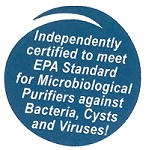
The bench-top unit is installed by unscrewing your existing aerator and screwing on the Seagull IV aerator with its integral diverter valve. This can be done in a matter of minutes.
How Does It Work?
The Seagull IV uses and advanced water purification technology known as the Structured Matrix™.
The Structured Matrix is an advanced water purification technology developed by General Ecology that purifies your water without using chemicals. It is the only technology certified to meet US EPA Standards against all three classes of waterborne disease organisms - parasitic cysts, bacteria, and viruses - instantly, without pre- or post-treatment, without wasting water and without electricity.
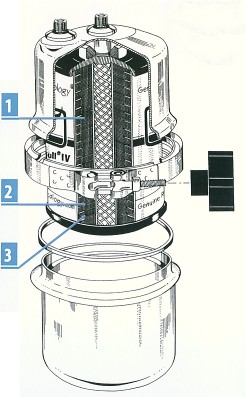 How it does this is a marvel of modern science.
There are three mechanisms that operate together to provide the purest water possible.
How it does this is a marvel of modern science.
There are three mechanisms that operate together to provide the purest water possible.
 1. Ultrafine Microstraining
1. Ultrafine Microstraining- Physically removes disease bacteria, pathogenic cysts like Giardia, Cryptosporidia, and other specific parasites and debris down to 0.1 microns (0.4 absolute). Removing the pathogens also removes the disease toxins they contain and is far more superior to "poisoning" organisms with pesticides and allowing the pathogen residue, toxins and pesticides to remain in the water to be consumed.
 2. Broad Spectrum Molecular Capture
2. Broad Spectrum Molecular Capture- Traps and captures specific organic and other chemicals such as pesticides, herbicides and solvents, as well as chlorine and other trace contaminates that can be toxic and/or carcinogenic, along with foul taste, odour and colour.
 3. Electrostatic Removal
3. Electrostatic Removal- Uses specially charge space-aged surfaces, essentially as magnets to remove minute particles, molecules and colloids suspended in the water.
All of these purification mechanisms work together to REMOVE viruses, disease-causing bacteria and other contaminants far smaller than submicron microfiltration alone can remove.
Contaminant Removal Capabilities
The Structured Matrix is highly effective in removing contaminants as the table demonstrates.

? = Comparisions are from general information. Performance varies widely within categories.
+ = Usually not effective against organic contaminants ordinarily found in drinking water. Check
manufacturers claims and text rests for specific information.
Microorganism Size Comparison
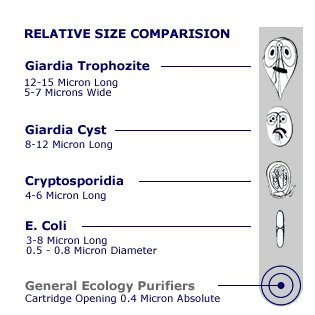 A micron is one millionth of a metre - or 1/1000th of a millimetre, if you like. Either way it is very small.
A micron is one millionth of a metre - or 1/1000th of a millimetre, if you like. Either way it is very small.
To be effective at removing Cryptosporidia, the US Center for Disease Control advises that filters must have a particle
retention size at least as small as 1.0 micron absolute. If the "pores" are any larger the cryptosporidia gets through.
The Structured Matrix has a particle retention size of 0.4 micron absolute and 0.1 micron nominal. The smaller nominal
particle retention size is the result of the three purification mechanisms working together as described earlier.
Since the particles (i.e. microorganisms) are physically removed from your drinking water you are not ingesting them as you would be if you simply
used a chemical purifier.
Who Else Uses It?
General Ecology, the manufacturer of the Seagull IV, has been in business for over 35 years and in that time has seen its products embraced by a wide-ranging customer base. In particular a number of major airlines use General Ecology Water Purifiers to provide pure water to their passengers.
Major International Airlines
|
|
Some Other Well-Known Customers are
|
|
SEAGULL IV X-1F RECOMMENDED...
"I fully endorse this product as excellent... In quality and performance, YOU GET WHAT YOU PAY FOR."
- Ronald D Coleman, Australia
"Thank you for...the Seagull IV X-1F water purifier. I am finding the water excellent and a pleasure to drink."
- D. Peake, Australia
"Very happy, excellent system."
- D & S Foote, Australia
"Thank you for...this exceptional quality water purifier. I would like to highly commend this Seagull IV Water Purifier. This is a stunning piece of craftsmanship that is exceptional value."
- Ms R. Armstrong, Australia
"We have been using Seagull IV and Aqua Polish filters for several years and we are extremely happy with the excellent water quality. The product enhances the quality and taste of the coffee and the pure water also inhibits any contaminants from entering the machines providing our customer with virtually maintenance free machines."
- Lino Sattin – Rio Coffee Service Manager, Australia
Now YOU Can Enjoy the Taste (And Safety!)
of Pure Water
Whenever You Want It
For peace of mind, convenience, ease of use, and guaranteed pure water there is nothing to compare to the Seagull IV series of water purifiers. You can rely on it.
To Your Better Health,

Michael Byrne
References:
- Cristina M. Villanueva, et al:Bladder Cancer and Exposure to Water Disinfection By-Products through Ingestion, Bathing, Showering, and Swimming in Pools in the American Journal of Epidemiology Vol 165 No 2 - 15 January 2007
